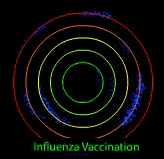 To help speed the fight
against cancer, Parabon is donating computing resources to major research centers
and universities, including:
To help speed the fight
against cancer, Parabon is donating computing resources to major research centers
and universities, including:Attention:
This page contains information found on research-oriented projects led by companies
and/or research communities.
Compute
Against Cancer (CAC) By: Parabon Computation
 To help speed the fight
against cancer, Parabon is donating computing resources to major research centers
and universities, including:
To help speed the fight
against cancer, Parabon is donating computing resources to major research centers
and universities, including:

Cancer Research
By: University of Oxford and United Devices
The National Foundation for Cancer Research (NFCR) Centre for Drug Discovery in the Department of Chemistry at the University of Oxford, England in partnership with United Devices search for cancer-fighting drugs using a peer-to-peer platform similiar to that of HMMER
Casino-21
By: University of Oxford
Casino-21 is a scientific experiment in large-scale Monte Carlo simulation of
the climate of the 20th and 21st centuries. In brief, users install a unique,
state-of-the art climate model on your home PC and keep it running, possibly
for a year or more. You'll still be able to use the PC as normal: just like
the SETI@home project the model will run as
a kind of screensaver as long as your PC is switched on and not in use.
EduCommons
By: Utah State University

"The EduCommons Project is an interdisciplinary approach to using technology
to help people learn, bringing together the power of five revolutionary ideas
from several academic areas:
The EduCommons Project, directed by David
Wiley, is currently under development at Utah State University."
(As found at http://www.educommons.org)
FightAIDS@Home
By: Entropia, The Scripps Research Institute
![]()
Participants: Entropia, Inc., the
Olson laboratory at The Scripps Research Institute (TSRI). Entropia's FightAIDS@Home
project attempts to model the evolution of drug resistance and designs the drugs
necessary to fight AIDS. Download client that talks to Entropia's network (see
GIMPS for similar platform)
Folding@Home
By: Pande Group, Stanford University

Another volunteer project that uses a screensaver or client application
based on the Mithral CS-SDK to simulate protein folding in an effort to better
understand how proteins self-assemble or fold. To study how this happens, requires
extremely intensive computations, since proteins fold no slower than a 10 microseconds
(10^-6 seconds), but we can only routinely simulate nanoseconds (10^-9 seconds).
These computations can be performed with thousands of processors in a distributed
environment.
The
Great Internet Mersenne Prime Search (GIMPS) By: Entropia

A Mersenne prime is a prime of the form 2P-1. The first Mersenne primes
are 3, 7, 31, 127, etc. There are only 38 known Mersenne primes. GIMPS was formed
in Jan. 1996 to discover new Mersenne primes. GIMPS has so far found the 4 highest
known Mersenne primes.
Contacts:
Scott Kurowski, (kuroski@entropia.com)
founder, Entropia.com, Inc.
George Woltman, (woltman@magicnet.net)
founder of the GIMPS.
Golem@Home
By: Hod Lipson and Jorday Pollack

The Golem@Home Project is a downloadable screensaver that randomly creates a
population of virtual robots on your system and then evolves them (the current
rule for evolution is survival of the robots who can move the greatest distance
over an infinite plain). Every week or so a few of your robots will move to
someone else's Golem screensaver and a few of someone else's robots will move
to your screensaver (you can disable this feature if you're worried about security).
These virtual robots contain Design information that can be used to build actual
working robots. While you participate, any creatures born (evolved) on your
computer are copyrighted to you.
Contacts:
Hod Lipson (lipson@cs.brandeis.edu)
and Jordan B. Pollack (pollack@cs.brandeis.edu)
HDDI
By: National Center for Supercomputing Applications and Lehigh University

National Center for Supercomputing Applications (NCSA) and Lehigh University
are developing an approach to indexing the Web called Hierarchical Distributed
Dynamic Indexing (HDDI TM). In short, HDDI accomplishes tasks that are not possible
with today's computer architecture. Today's search engines use static indexing
and single word search to identify relevance across a small sample of the entire
Internet. HDDI on the other hand enables real-time searching of the entire Internet
by identifying the relevance of a phrase, not just key words.
HMMER
By: United Devices, University of Washington, St. Louis

A bioinformatics research project for the University of Washington in St. Louis,
Missouri. The project uses the Hidden Markov Modeling technique to compare known
DNA sequences (amino acids) against the data from the Human Genome Project to
find similar sequences.
Influenza
Vaccination By: Popular Power

OceanStore
By: University of California, Berkeley
![]()
OceanStore comprises a federation of utility providers who cooperate to synthesize
a seamless, consistent, highly-available, mobile data platform. It is a component
of the Endeavour project at Berkeley.
Unlike other file systems, OceanStore provides truly nomadic data that is free
to migrate and be replicated anywhere in the world.
SETI@home
By: University of California, Berkeley

A downloadable screensaver (client) allows anyone with a computer and an Internet
connection to take part in the search for extraterrestrial life (analysis of
radio waves gathered by the Arecibo telescope located in Puerto Rico).
How it works:
Contacts:
David Anderson (davea@ssl.berkeley.edu),
Project Director at University of California-Berkeley.
Dan Werthimer (danw@ssl.berkeley.edu),
Chief Scientist.